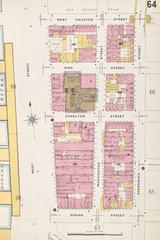The High Line New York City: Visiting Hours, Tickets, and In-Depth Guide to Historical Sites
Date: 14/06/2025
Introduction
The High Line is a landmark example of urban transformation, blending Manhattan’s industrial history with innovative landscape design and vibrant public art. Once an elevated freight rail line, it now stands as a 1.45-mile (2.33 km) linear park on Manhattan’s West Side, offering a unique perspective on New York City’s past, present, and future. This comprehensive guide provides everything you need to plan your visit—including the High Line’s history, visiting hours, ticket information, accessibility, nearby attractions, and insider tips for the best experience.
Table of Contents
- Introduction
- Historical Background
- Visiting the High Line: Hours, Tickets, and Accessibility
- Guided Tours and Special Events
- Travel Tips for Visitors
- Nearby Attractions
- Art, Gardens, and Architecture
- Practical Amenities and Safety
- Frequently Asked Questions (FAQ)
- Conclusion and Planning Resources
- References
Historical Background
Early 20th Century Origins
The High Line’s story begins in the early 1900s, when the west side of Manhattan faced hazardous street-level freight rail traffic. Tenth Avenue was so dangerous it was called “Death Avenue,” with “West Side cowboys” riding ahead of trains to warn pedestrians and vehicles (nyhistory.org). Despite these precautions, accidents were frequent.
The West Side Improvement Project
To address these hazards, the City of New York and the New York Central Railroad launched the West Side Improvement Project. Completed in 1934, the High Line elevated rail traffic above street level, removing 105 dangerous crossings and boosting industrial efficiency (nyhistory.org, newyorkcityfamily.com).
Community Advocacy and the Woman’s League
During construction, community groups like the Woman’s League for the Protection of Riverside Park advocated for design modifications to preserve neighborhood green space and aesthetics (nyhistory.org).
Decline, Abandonment, and Renewal
With the rise of interstate trucking in the mid-20th century, rail traffic on the High Line dwindled. The last train ran in 1980, and the structure was left to deteriorate (wikipedia.org). In the late 1990s, neighborhood activists Joshua David and Robert Hammond founded Friends of the High Line, rallying support to preserve and repurpose the structure as a public park (newyorkcityfamily.com). Through collaboration with landscape architects James Corner Field Operations, Diller Scofidio + Renfro, and Piet Oudolf, the High Line was reborn. The first section opened in 2009, with the final segment completed in 2014 (wikipedia.org, elikarealestate.com).
Visiting the High Line: Hours, Tickets, and Accessibility
Hours
- Open Daily: 7:00 a.m. to 10:00 p.m. (hours may vary seasonally; winter closing typically at 8:00 p.m.)
- Check for Updates: Always verify hours on the official High Line website before your visit.
Tickets and Admission
- Free Entry: No tickets or reservations are required for general admission.
- Special Events & Tours: Free and paid guided tours are available and may require advance booking.
Accessibility
- Wheelchair Accessible: Elevators at Gansevoort, 14th, 16th, 23rd, and 30th Streets; ramps at 30th Street Hudson Yards.
- Stroller-Friendly: Paths are paved and mostly flat.
- Service Animals: Permitted; pets are not allowed (newyorkbyrail.com).
Guided Tours and Special Events
- Guided Tours: Seasonal free walking tours like “From Freight to Flowers” provide in-depth history and design insights. Check the official website for schedules.
- Special Events: The High Line hosts rotating public art installations, performances, and community activities year-round (official events calendar).
Travel Tips for Visitors
- Best Times: Early mornings and weekdays for fewer crowds; evenings for sunsets (but busier).
- Walking the High Line: The full route takes 30–60 minutes at a relaxed pace. Benches and lawns are available for breaks.
- Weather: The park is open in most weather conditions; dress appropriately.
- Photography: Gansevoort Street, 23rd Street Overlook, and the 30th Street section offer iconic photo opportunities.
Nearby Attractions
- Chelsea Market: Food hall and shopping at 15th Street (newyorkbyrail.com).
- Whitney Museum of American Art: At the park’s southern end (newyorkbyrail.com).
- Hudson Yards: Modern multi-use development with the Vessel and Edge observation deck (newyorkbyrail.com).
- Gansevoort Market: Food market in the Meatpacking District.
Art, Gardens, and Architecture
- Public Art: The High Line features rotating sculptures, murals, and large-scale installations, especially at the Plinth near 30th Street.
- Gardens: Over 500 plant species, curated by Piet Oudolf, offer a wild, seasonally-changing landscape.
- Landmarks: Industrial rail tracks and steel beams are integrated into the design. Architectural highlights include Zaha Hadid’s 520 West 28th Street and the Standard Hotel (exp1.com).
Practical Amenities and Safety
- Restrooms: Available at Gansevoort Street, 16th Street, 30th Street, and 31st Street & Dyer Avenue.
- Food Vendors: Seasonal offerings include ice cream, gelato, street food, and coffee near 15th Street (exp1.com).
- Seating: Benches, deck chairs, and lawns throughout.
- Bike Racks: At access points (cycling on the High Line is not permitted).
- Safety: Security personnel present; the park is well-lit and monitored.
Frequently Asked Questions (FAQ)
Q: Is admission to the High Line free?
A: Yes, general entry is free.
Q: Are pets allowed?
A: Only service animals are permitted.
Q: What are the High Line’s hours?
A: Typically 7:00 a.m. to 10:00 p.m.; check for seasonal changes.
Q: Is the park accessible for wheelchairs and strollers?
A: Yes, elevators and flat paths are available at major entrances.
Q: Are there guided tours and events?
A: Yes, free and paid tours are available; check the event calendar for details.
Q: Can I bring food and drinks?
A: Yes, but alcohol is prohibited.
Q: Are there restrooms?
A: Yes, at several access points.
Conclusion and Planning Resources
The High Line is a testament to New York City’s ability to reinvent itself while honoring its past. Its combination of sustainable landscaping, public art, historical interpretation, and integration with vibrant neighborhoods makes it a must-see destination for locals and visitors alike. Plan your visit by checking the official High Line website for current information on hours, events, elevator status, and safety protocols.
For a richer experience, download the Audiala app for self-guided tours, interactive maps, and insider tips. Share your photos and stories with #HighLineNYC and follow official channels for real-time updates.
References
- A Piece of High Line History, New-York Historical Society (nyhistory.org)
- Railway Elevated Park Revival: The High Line, New York City Family (newyorkcityfamily.com)
- High Line, Wikipedia (wikipedia.org)
- The High Line, Elika Real Estate (elikarealestate.com)
- The High Line, New York By Rail (newyorkbyrail.com)
- Most Popular Attractions NYC, New York Dearest (newyorkdearest.com)
- 8 Must-Sees Along High Line, Exp1 (exp1.com)
- The Story Behind The High Line in New York City, Rost Architects (rostarchitects.com)


























































































































































































































































































